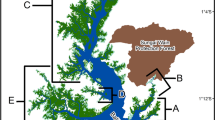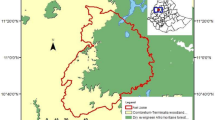Abstract
Background, aim, and scope
The Yunnan snub-nosed monkey is one of the most endangered primates in the world. It is experiencing a range of ongoing threats and the persisting effects of past disturbances. The prospects for this species are not very optimistic because habitat corridors are severely damaged by logging, grazing, and mining. Each group of the monkeys in different areas is facing a unique variety of threats. Based on genetic analysis, Rhinopithecus bieti should be separated into three management units for conservation, of which the Mt. Laojun management unit involves the most endangered primates. Despite the fact that the vegetation on Mt. Laojun is in a relatively pristine state, only two groups of monkeys, of a total of fewer than 300, survive in the area. With this paper, we aimed to address the capacity of the monkeys’ habitat at the study site and the possible reasons for the small populations.
Materials and methods
Rapid ecological assessment based on a SPOT 5 image and field survey was used to simulate the vegetation of the whole area based on reference ecological factors of the GIS system. The vegetation map of the site was thus derived from this simulation. Based on the previous studies, the three vegetation types were identified as the suitable habitat of the monkeys. The confusion matrix-based field GPS points were applied to analyze the precision of the habitat map. Based on the map of suitable habitat of the monkeys, the utilization of the habitat and the carrying capacity were analyzed in the GIS.
Results
The confusion matrix-based field GPS points were applied to the habitat analysis process, and it was found that the habitat map was 81.3% precise. Then, with the current habitat map, we found that the mixed forest currently used by the monkeys is only a very small fraction (2.65%) of the overall potential habitat of the population, while the dark conifer forest is 4.09%.
Discussion
Poaching is the greatest short-term threat to this species, particularly in the southern range where local residents have a strong tradition of hunting. Quite a few individual monkeys are still trapped accidentally due to the high density of traps. These problems are hard to mitigate because it is difficult to enforce laws due to the extremely rugged terrain.
Conclusions
The results show that there is a great ecological capacity of the area for the monkey’s survival and a great potential for an expansion of the monkey population at the site. Based on the current population and its geographical range, it can be estimated that the suitable habitat area defined by this study can support more monkeys, about many times the current population. Thus, at least in the Mt. Laojun Area, poaching pressure is the main factor to be responsible for the low density of Yunnan snub-nosed monkeys instead of habitat alteration.
Recommendations and perspectives
Based on these results, some suggestions relating to conservation can be made: Focus conservation efforts on the current distribution area of the monkeys and create a 20 km buffer zone; design a long-term plan for the suitable habitat outside the buffer zone to set up a wildlife corridor in the long run; establish an association for the local hunters exploiting, their knowledge on the animals to promote monkey conservation and stop poaching. Also, the map derived from the study helps managers to allocate conservation resources more efficiently and enhances the overall outcomes of conservation measures.


Similar content being viewed by others
References
Bai SC (1987) Survey on hunting of Yunnan golden monkeys. ChinWildl 1:14–15 13 (in Chinese)
Baillie J, Groombridge B (eds) (1996) 1996 IUCN red list of threatened animals. IUCN, Gland
Cui LW, Sheng AH, He SC, Xiao W (2006) Birth seasonality and interbirth interval of captive Rhinopithecus bieti. Am J Primatol 68:457–463
Kirkpatrick RC (1996) Ecology and behavior of the Yunnan snub-nosed langur (Rhinopithecus bieti, Colobinae) [dissertation]. University of California, California
Kirkpatrick RC, Long YC, Zhong T, Xiao L (1998) Social organization and range use in the Yunnan Snub-nosed Monkey Rhinopithecus bieti. Int J Primatol 19:13–51
Li B, Yang C (2000) Ecology. Higher Education Press, Beijing, pp 348–349
Liu ZJ, Ren BP, Wei FW, Long YC, Hao YL, Li M (2007) Phylogeography and population structure of the Yunan snub-nosed monkey (Rhinopithecus bieti) inferred from mitochondrial control region DNA sequence analysis. Molec Ecol 16:3334–3349
Long YC, Kirkpatrick RC, Zhong T, Xiao L (1996a) Status and conservation strategy of the Yunnan snub-nosed monkey. Chin Biodiv 4:145–152 (in Chinese with English abstract)
Long YC, Zhong T, Xiao L (1996b) Study on geographical distribution population and conservation strategy of the Yunan snub-nosed monkey. Ecol Economy 1
Ren BP, Li M, Long YC, Cyril CG, Wei FW (2008) Measuring daily ranging distances of Rhinopithecus bieti via global positioning system collar at Jinsichang, China: a methodological consideration. Int J Primatol 29:783–794
Ren BP, Li M, Long YC, Wei FW (2009) Influence of day length,ambient temperature, and seasonality on daily travel distance in the Yunnan snub-nosed monkey at Jinsichang, Yunnan, China. Am J Primatol 71:233–241
Roger S, Ellen R, Gina S, Bruce Y (2000) Nature in focus (Rapid Ecological Assessment). Island, Washington DC, pp 33–37
Xiang Z-F, Hou S, Wang L, Cui LW, Quan RC, Zhong T (2007a) Distribution, status and conservation of the black-and-white snub-nosed monkey Rhinopithecus bieti in Tibet. Oryx 41(4):525–531
Xiang Z-F, Hou S, Xiao W, Quan RC, Grueter CC (2007b) Diet and feeding behavior of Rhinopithecus bieti at Xiaochangdu, Tibet: adaptations to a marginal environment. Am J Primatol 69:1141–1158
Xiao W, Ding W, Cui LW, Zhou RL, Zhao Q-K (2003) Habitat degradation of Rhinopithecus bieti in Yunnan, China. Int J Primatol 24(2):389–398
Zhao Q-K (1996) Ecological information on statistics of human population and agriculture in Hengduan Mountains from Yunnan. Chin Biodiv 4:217–221 (in Chinese with English abstract)
Zhao Q-K (1998) Status of the Yunnan snub-nosed monkey. Primate Conserv 9:131–134
Acknowledgments
This study was supported by the National Natural Science Foundation of China (NSFC no. 30470310), Key Project of Foundation of China (30630529) and Critical Ecosystem Partnership Fund (CEPF ID: 1056744064), and Key Projects in the National Science & Technology Pillar Program during the Eleventh Five-Year Plan Period (ID: 2007BAC03A08). We would like to acknowledge the contribution of Shangri-La Alpine Botanical Garden in technical support to my field work. Special thanks are given to Professor Qi-kun Zhao and Professor Li Diqiang at the Chinese Academy of Forestry Science for their generosity in providing resourceful comments for designing the study, to Dr. Wong Hengzhi at Yunnan University, to Dr. Cyril C. Gueter at Zurich University, and to Mr. Deng X-Q, Mr. Ma J, Mrs. Zhuang J-Y, and Mrs. Luo Y-M, conservation information specialists with TNC’s China Program, for their valuable suggestions on data integration and processing.
Author information
Authors and Affiliations
Corresponding author
Additional information
Responsible editor: Ding Wang
Rights and permissions
About this article
Cite this article
Li, L., Yu, S., Ren, B. et al. A study on the carrying capacity of the available habitat for the Rhinopithecus bieti population at Mt. Laojun in Yunnan, China. Environ Sci Pollut Res 16, 474–478 (2009). https://doi.org/10.1007/s11356-009-0130-8
Received:
Accepted:
Published:
Issue Date:
DOI: https://doi.org/10.1007/s11356-009-0130-8




